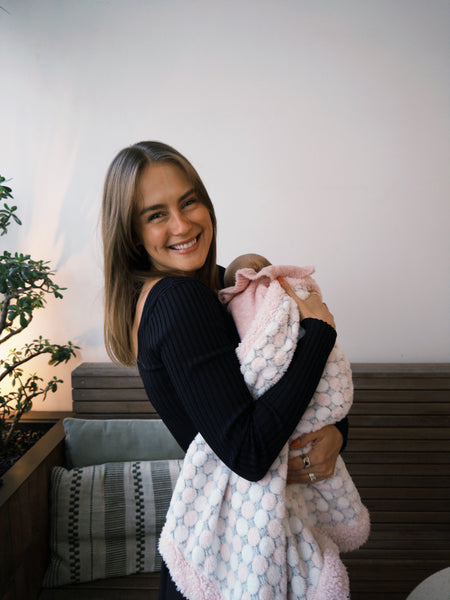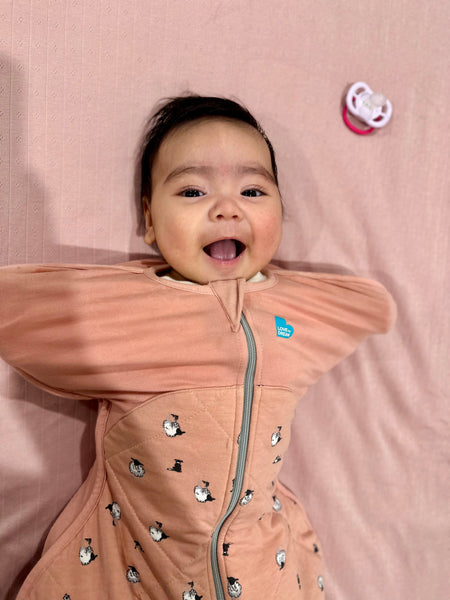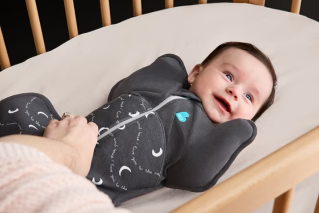What is hip dysplasia in babies?
Developmental Dysplasia of the Hip (DDH), or clicky hips as it’s commonly referred to, is where the head of the femur bone doesn’t sit in the hip socket correctly. The ligaments of the hip joint may also be loose. This can cause the hip to become unstable and will cause problems further down the line if left untreated.
Typically, only hip is affected, although in some cases, both hips may be involved. DDH can occur at birth or develop in the weeks and months that follow. DDH can vary from mild to severe but usually isn’t painful. However, it can become troublesome later in life if left untreated.
What can cause hip dysplasia in babies?
From family history to the sex of your child, discover the most common risk factors for hip dysplasia below.
-
Genetics: Higher risk with family history.
-
Gender: Females are 2-5 times more likely to develop hip dysplasia than males.
-
Womb Factors: Breech position or low amniotic fluid.
-
Firstborn: Increased risk in firstborn children.
-
Neuromuscular Disorders: Higher risk with conditions like cerebral palsy.
-
Post-Birth Positioning: Tight swaddling or improper carriers can hinder hip development.
What are the signs of hip dysplasia in babies and children?
Doctors and midwives will examine your child’s hips when they are born. Your GP will continue to check your child’s hips at every appointment over the first 12 months.
If you’re concerned that your child might have hip dysplasia, look out for the below signs.
Common signs to look out for in babies:
- Your baby’s legs are tight when you try to open them to change their nappy.
- Your baby has uneven skin folds on their thighs.
- One of your baby’s legs appears shorter than the other.
Common signs to look out for in older children:
- Your child took longer than average to learn how to sit up or walk.
- Your child prefers one side while crawling
- Your child may limp or walk with one leg turned outward
- There is a popping or clicking sound when the hip joint moves.
What age does hip dysplasia show?
DDH is usually diagnosed shortly after birth, but can also appear later in life. Parents and caregivers should keep an eye out for the common signs and symptoms of DDH. If concerned, please speak to your GP.
DDH is usually diagnosed with an ultrasound or x-ray. Ultrasound is recommended for infants six months or younger while X-ray is preferred for children older than six months.
How common is hip dysplasia in babies?
Hip dysplasia is common in Australia, affecting about one in 100 children. It is more prevalent in first-borns and females.
What is the most common management of a newborn with hip dysplasia?
The treatment for hip dysplasia in babies depends on the severity of the condition and the age of the child. Early detection and intervention significantly improve the chances of successful treatment.
A special brace
The Pavlik Harness and Denis Browne Bar are commonly used to treat mild DDH. The braces are designed to hold your child’s hip in the correct position so that the joint can develop properly. A brace is usually worn for a few months until the hip is stable.
Closed reduction procedure
If the Pavlik harness or brace is ineffective, or if hip dysplasia is diagnosed after six months of age, your child may need a closed reduction procedure. This involves repositioning the hip joint under anaesthesia and placing the child in a spica cast to maintain proper alignment during healing.
Open reduction surgery
In severe or late-diagnosed cases, open reduction surgery may be required. The surgeon repositions the hip joint surgically and may use pins, screws, or plates to stabilize it. Following the surgery, a spica cast is applied to protect the hip joint during the healing process.
How long do babies wear a Pavlik Harness for?
A Pavlik Harness is worn for as long as the doctor recommends, which is usually around six to 12 weeks. The harness will hold your child’s legs in a frog-like position which enables the pelvic sockets to deepen around the thigh bone and allows the hip joint to stabilise.
How do babies sleep with hip dysplasia?
Babies should always be put to sleep on their backs from birth. Children with hip dysplasia should not be put to sleep with their legs or hips held straight in extension.
The best sleep position for children with hip dysplasia is where the knees naturally fall apart with the thighs supported and hips and knees bent. This is called the M-position, straddle position, or jockey position. It is a position designed to promote natural hip development.
What is the best sleeping position for hip dysplasia?
Babies should always be put to sleep on their backs to reduce the risk of SIDS (sudden infant death syndrome). The best sleep position for children with hip dysplasia is where their knees naturally fall apart with the thighs supported and hips and knees bent. This is called the M-position, straddle position, or jockey position. This position is designed to promote natural hip development.
What positions should be avoided with hip dysplasia?
Children with hip dysplasia should avoid sleeping with their legs held straight in extension with the knees and hips stretched out. Free movement of the hips will promote natural hip development.
Should you swaddle a baby with hip dysplasia?
Babies with hip dysplasia can be swaddled. Designed to help children with DDH, our Swaddle Up Hip Harness Original™ can be worn over a Pavlik Harness, Denis Browne Bar (DBB), and a Rhino brace.
When your child shows signs of rolling over or pulling up onto their hands, you must stop swaddling. Our Swaddle Up Transition Bag Hip Harness Original™ will provide your child with support on the journey towards more independent sleep.











